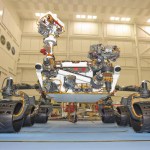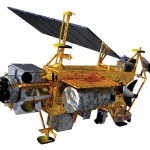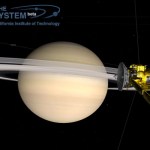Cosmos
It is called Comet Elenin.
Latest indications are this relatively small comet has broken into even smaller, even less significant, chunks of dust and ice. This trail of piffling particles will remain on the same path as the original comet, completing its unexceptional swing through the inner solar system this fall.
"Elenin did as new comets passing close by the sun do about two percent of the time: It broke apart," said Don Yeomans of NASA's Near-Earth Object Program Office in Pasadena, Calif. "Elenin's remnants will also act as other broken-up comets act. They will trail along in a debris…
A mystery that began nearly 2,000 years ago, when Chinese astronomers witnessed what would turn out to be an exploding star in the sky, has been solved. New infrared observations from NASA's Spitzer Space Telescope and Wide-field Infrared Survey Explorer, or WISE, reveal how the first supernova ever recorded occurred and how its shattered remains ultimately spread out to great distances.
The findings show that the stellar explosion took place in a hollowed-out cavity, allowing material expelled by the star to travel much faster and farther than it would have otherwise.
"This supernova…
Pronounced Quake.
(click for source)
No, NOT your granddady's model rocket club. The following video documents one of the more amazing model rocket launches ever. BE WARNED: There are VERY LOUD AND OBNOXIOUS SOUNDS on this video. apparently, you can hear the screams in space!
Enjoy:
Curiosity is a new Mars Rover that looks like a UFO when it's all folded up in its space-pod, but looks like a Transformer when it is deployed.
The space travelling robot has been folded up and sealed into its anti-germ container (to avoid letting germs out into the Martian ecosystem, the rover is sterilized and sealed up) in preparation for its launch, which is coming up soon.
According to NASA, Launch Window opens at 10:21 EST on November 25th. Arrival at the planet Mars is expected in August, 2012 .
The main thing this robot is curious about is the presence of microbial life, past or…
Remember the gravity mapping project on the moon?
NASA's Gravity Recovery And Interior Laboratory (GRAIL)-B spacecraft successfully executed its first flight path correction maneuver Wednesday, Oct. 5. The rocket burn helped refine the spacecraft's trajectory as it travels from Earth to the moon and provides separation between itself and its mirror twin, GRAIL-A. The first burn for GRAIL-A occurred on Sept. 30.
"Both spacecraft are alive and with these burns, prove that they're kicking too, as expected," said David Lehman, GRAIL project manager at NASA's Jet Propulsion Laboratory in Pasadena…
NASA will hold a news conference at 1 p.m. EDT (10 a.m. PDT) on Thurs., Sept. 29, to reveal near-Earth asteroid findings and implications for future research. The briefing will take place at NASA Headquarters in Washington.
NASA's Wide-field Infrared Survey Explorer (WISE) mission, launched in December 2009, captured millions of images of galaxies and objects in space. During the news conference, panelists will discuss results from an enhancement of WISE called Near-Earth Object WISE (NEOWISE) that hunted for asteroids.
Details here.
Tonight and tomorrow, there should be auroras visible much much farther south than normal. According to Universe Today you should see Auroras in most US states north of the southern tier of states. Unless they are exaggerating. Worth a look.
Or, for that matter, a solar eclipse? If the moon is going around the earth once a month shouldn't the moon's shadow fall on the earth (a solar eclipse) every month, and the earth's shadow fall on the moon (a lunar eclipse) once a month?
Yes, it should,and all the planets and moons and stuff should all be on the same flat plane with the sun in the "middle." Someday astronomers will find a solar system with several planets and they'll name it something special because it will be very rare.
Anyway, this came up in conversation and the conversation led to some googling around and this nice…
As you know, the UARS (Satellite) is in the process of de-orbiting. It is a bit more like a death watch (have you ever done one of those?) than a technological procedure. The satellite was pushed into a dangerous orbit that would drag it down within several days, and it is now losing its grip on orbital inertia as it plows ungracefully through thicker and thicker regions of the upper atmosphere. One wonders what might affect UARS's orbit. Would a powerful weather front with tall thunderheads, or a hurricane cause enough extra molecules of air to be pushed up a bit farther, to cause the…
NASA's WISE (Wide-field Infrared Survey Explorer ) telescope has collected some important data on black holes, in particular, about the big jets of energy that stream out of them.
Scientists study jets to learn more about the extreme environments around black holes. Much has been learned about the material feeding black holes, called accretion disks, and the jets themselves, through studies using X-rays, gamma rays and radio waves. But key measurements of the brightest part of the jets, located at their bases, have been difficult despite decades of work. WISE is offering a new window into…
According to the latest estimates from NASA, the Upper Atmosphere Research Satellite will re-enter the Earth's atmosphere next Thursday, Friday or Saturday. It will strike somewhere between .... well, it will strike the earth somewhere, not likely near the poles. Could hit anywhere, really.
UPDATE HERE
The satellite was launched in 1991 via Discovery, and has collected whopping huge piles of extremely important data. It weighs 5,668 kilograms. UARS was decomissioned on December 15th, 2005 and at that time, lowered into a "disposed orbit"
In case a piece of UARS falls near you, the…
The asteroid Baptistina has been on trial for several years, implicated in the K/T Boundary mass extinction event that killed off the dinosuars. But the jury is finally in. Baptistina is off the hook.
Observations from NASA's Wide-field Infrared Survey Explorer (WISE) mission indicate the family of asteroids some believed was responsible for the demise of the dinosaurs is not likely the culprit, keeping open the case on one of Earth's greatest mysteries.
While scientists are confident a large asteroid crashed into Earth approximately 65 million years ago, leading to the extinction of…
The existence of a world with a double sunset, as portrayed in the film Star Wars more than 30 years ago, is now scientific fact. NASA's Kepler mission has made the first unambiguous detection of a circumbinary planet -- a planet orbiting two stars -- 200 light-years from Earth.
Unlike Star Wars' Tatooine, the planet is cold, gaseous and not thought to harbor life, but its discovery demonstrates the diversity of planets in our galaxy. Previous research has hinted at the existence of circumbinary planets, but clear confirmation proved elusive. Kepler detected such a planet, known as Kepler-…
It has been something of a struggle over the years for the people of the Minnesota Planetarium Society. They've been trying to get a planetarium in Minneapolis for some time now, but for a number of reasons (not their fault) this has proved too difficult. Now there is good news. The Bell Museum, which is part of the University of Minnesota, will "absorb" the planetarium project, and eventually, there may very well be a dome that will replicate the night sky in Minnesota. I spoke with Nathan Laible, the Board Chair of the widely respected Minnesota Planetarium Society about the Planetarium…
Probably not, but they are cagily announcing a rather unusual press conference that has a certain familiar ring to it.
MOFFETT FIELD, Calif. -- NASA will host a news briefing at 11 a.m. PDT, Thursday, Sept. 15, to announce a new discovery by the Kepler mission. The briefing will be held in the Syvertson auditorium, building N-201, at NASA's Ames Research Center in Moffett Field, Calif. The event will be carried live on NASA Television and the agency's website...
The Kepler mission is focused on finding Earth-size planets in the Goldilocks Zone, where, say, alien life could live. But of…
CAPE CANAVERAL, Fla. -- NASA's twin lunar Gravity Recovery and Interior Laboratory (GRAIL) spacecraft lifted off from Cape Canaveral Air Force Station in Florida at 9:08 a.m. EDT (6:08 a.m. PDT) Saturday, Sept. 10, to study the moon in unprecedented detail.
GRAIL-A is scheduled to reach the moon on New Year's Eve 2011, while GRAIL-B will arrive New Year's Day 2012. The two solar-powered spacecraft will fly in tandem orbits around the moon to measure its gravity field. GRAIL will answer longstanding questions about the moon and give scientists a better understanding of how Earth and other…
On the face of it, it is impossible. Cosmic rays vary over time, and climate varies over time, and the two variations do not correspond. Global temperature has been going up over the last century, in correspondence with increased of atmospheric CO2, and this makes sense because the physics says that CO2 is a greenhouse gas, and this whole global warming thing is a greenhouse effect. Bringing cosmic rays into the situation seems both unnecessary and difficult to do.
But it turns out that there is a cosmic ray - climate connection which is interesting if it turns out to be true. But this…
NASA is giving the public the power to journey through the solar system using a new interactive Web-based tool.
The "Eyes on the Solar System" interface combines video game technology and NASA data to create an environment for users to ride along with agency spacecraft and explore the cosmos. Screen graphics and information such as planet locations and spacecraft maneuvers use actual space mission data.
"This is the first time the public has been able to see the entire solar system and our missions moving together in real time," said Jim Green, director of NASA's Planetary Science Division…
Here is an extended quote from the Preface of a new publication you may find interesting. I thought it was fascinating:
In 1995, the National Research Council's (NRC's) Committee on Space Debris wrote,
The threat that orbital debris poses to international space activities is presently not large, but it may be on the verge of becoming significant. If and when it does, the consequences could be very costly--and extremely difficult to reverse. By contrast, the cost of reducing the growth of the hazard can be relatively low....The committee believes that spacefaring nations should take…
After a journey of almost three years, NASA's Mars Exploration Rover Opportunity has reached the Red Planet's Endeavour crater to study rocks never seen before.
On Aug. 9, the golf cart-sized rover relayed its arrival at a location named Spirit Point on the crater's rim. Opportunity drove approximately 13 miles (21 kilometers) since climbing out of the Victoria crater.
"NASA is continuing to write remarkable chapters in our nation's story of exploration with discoveries on Mars and trips to an array of challenging new destinations," NASA Administrator Charles Bolden said. "Opportunity's…





